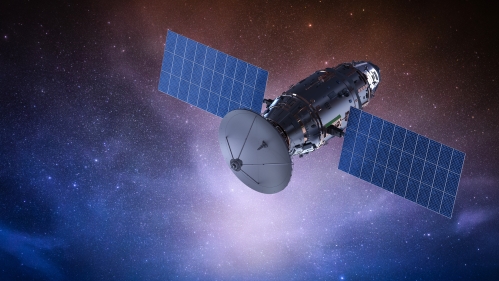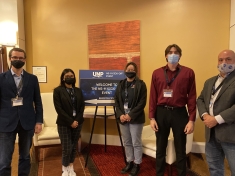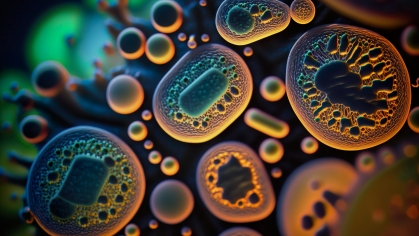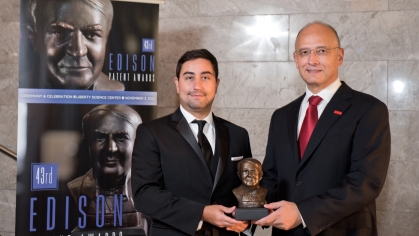Rutgers Engineering Selected for Prestigious Air Force Research Lab Satellite Program

Assistant Professor Laurent Burlion and students travel to Albuquerque for program kick-off
Nanosatellites, or CubeSats, made of modules each measuring just shy of four inches square, are increasingly deployed for space research. The Air Force Research Lab (AFRL) recently selected Rutgers as one of ten universities to participate in the 11th cycle of its University Nanosatellite Program (UNP).
“Rutgers is the underdog,” states Laurent Burlion, an assistant professor in the School of Engineering’s Department of Mechanical and Aerospace Engineering. “This is the first time Rutgers is participating in this program and it’s exciting.”
In 2016 – only five years ago -- Rutgers became the first public university in New Jersey to offer a degree in aerospace engineering. Inclusion in the AFRL satellite program, according to Burlion, reflects the growing national profile of the School of Engineering’s aerospace engineering degree program.
A Two-Year Partnership
During the two-year Phase 1 Program, Rutgers students will design, fabricate, and test CubeSats, with support from a $220,000 program equipment grant. For students interested in aerospace, this is a unique opportunity to take part in a program designed to train the next generation of aerospace engineers to work on satellites and test new scientific projects.
In 2024, after completing the first two years of the partnership program, the AFRL will select three universities to continue with the program.
“At that time, we will be asked to demonstrate that we can design a nanosatellite and have assembled the elements to launch a satellite with an interesting science payload to test,” Burlion explains.
But first, he will oversee students as they develop new algorithms and software to better control a three-module CubeSat. “Satellite fuel can slosh, which can affect the movement and orientation of the satellite,” he says. “When the liquid sloshes, the satellite might vibrate and oscillate. We hope to find a better way to make a maneuver without inducing oscillation.” Rutgers’ winning proposal will include a cylindrical tank in one of the miniaturized satellites three modular units.

An Exciting Kick-off
In January, the AFRL held a three-day program kick-off in Albuquerque, New Mexico. To ensure smooth transitions among student participants throughout Phase 1, Burlion invited four students – graduate student Mike Fogel, senior Connie Liou, junior Joseph Petrocelli, and sophomore Sarah Terracina – to accompany him. Liou, Burlion noted, “ is really passionate about space. She was involved in writing our project proposal and has played, so far, a great role in this project.”
“The AFRL presented the programs,” Burlion reports. “Every team presented its project and students learned how to work on the mission on small projects with materials supplied by AFRL. This training on how to design a satellite was a good initiation to the real project.”
Graduate student Mike Fogel left Albuquerque with two big takeaways. “First the AFRL has very structured approach to bringing these satellites from concept to launch, which is beneficial to the program here at Rutgers,” he recalls. “Second, the AFRL team is there to help. They take a proactive approach to working with each school. I think their guidance will be invaluable going forward.”
Sophomore aerospace major and astronomy minor Sarah Terracina also enjoyed the team culture in Albuquerque, which “is built around encouragement, education, and efficiency. Every engineer I met and worked with was genuinely invested in teaching me how to lead a successful space mission,” she says.
“I also learned that the program is not a competition against other schools – it’s against ourselves – and whether we overcome our own challenges and organize ourselves to meet program requirements,” she adds.
A Unique Learning Tool Open to All
As an “older adult” graduate student working under Burlion, Fogel brings a unique perspective to the program. “I’m afforded the opportunity to look at this entire project as both a learning tool and also as a unique life experience,” he says. “This has directly influenced my decision to enter the aerospace Ph.D. program immediately after completing my master’s degree in May. I plan to stick around and see this build through all the way to launch!”
For Terracina, who hopes for a career engineering astronautical research missions, the project provides invaluable hands-on experience. “Dr. Burlion has a good leadership style of trusting students with real responsibilities and letting us have ownership of this project,” she says.
Since the project is a multidisciplinary STEM project, it is open to any student who would like to join. As Terracina puts it, “No experience is necessary – we are learning together.”
Burlion’s enthusiasm for the project is palpable. “For me, this is very exciting. We may be new to the AFRL program, but I think our science is interesting and we will have a very good chance to be selected to continue into Phase 2 in January 2024,” he predicts.


